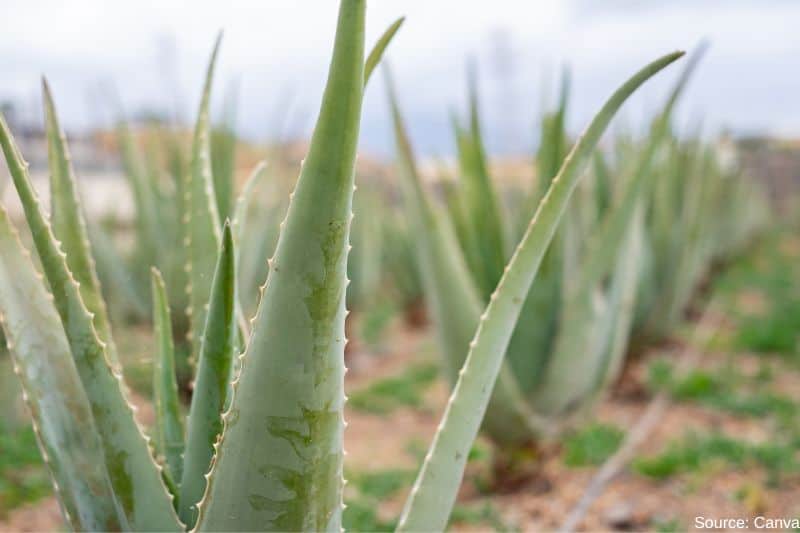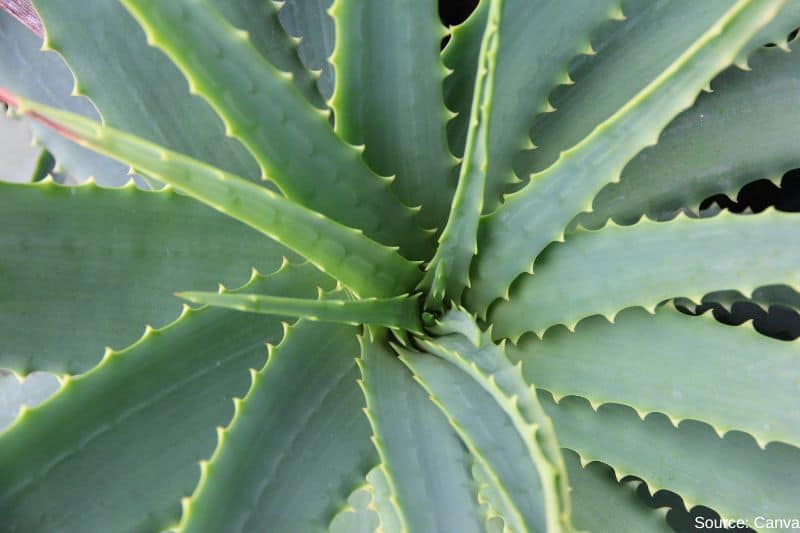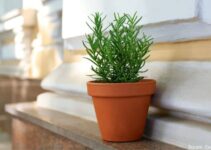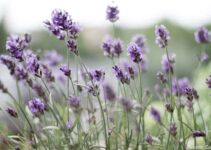Are your aloe vera leaves curling? Well, you’re not alone. Aloe vera leaves curling is a common occurrence among aloe vera lovers.
And let’s be honest; it can be quite concerning to see the once sturdy and erect leaves begin to bow — to say the least.
So, why are your aloe vera leaves curling?
Well, aloe vera leaves can curl for several reasons:
- Improper watering
- Inadequate sunshine
- Abrupt temperature change
- Change in conditions
- Poor soil drainage
Of course, there are more reasons aloe vera leaves may curl.
Read: What is Electroculture Gardening?
In this article, I’ve mustered everything you need to know about your aloe vera leaves curling. Spanning from the common causes to measures you can take to avoid and fix the problem, there’s so much lined up for you today, so read on!
7 Possible Reasons Aloe Vera Leaves Curl
We all love seeing our indoor plants healthy. So, when you begin to notice changes in the posture of your aloe vera plant, it should be more than enough to get you concerned. Let’s look at some potential causes of your plant’s laxity in form.
1. Improper Watering
One of the common causes of drooping aloe leaves is improper watering. Aloe veras are arid plants that do best with little water (heavy but irregular watering).
If you’ve recently increased the frequency of your watering, that’s likely why the leaves are beginning to bend downwards.
Ideally, you should water your aloe vera once in two or three weeks during the hot months. This is the time it will take for the soil to get completely dry during this moment of the year, especially if you’re keeping the plants indoors.
In the colder months, watering needs to be even more sparingly. The rule of thumb is to double the period you take to water the plants in hotter months. That means once every 4 to 6 weeks and again, only after the soil has completely dried out. Otherwise, you risk making the plants become droopy as you’re already seeing.
2. Inadequate Sunshine
Aloe veras are native to North Africa, Canary islands, and North Europe. In other words, these plants were originally meant to withstand many hours in the sun day in day out and will only remain healthy if they get that amount of sunshine.
So, if your current placement doesn’t allow the plant to get enough sunshine, that could be the cause of the problem you now have at hand.
For healthy growth, aloe veras need at least 6 hours of exposure to sunshine. Anything less than that can make their leaves appear lethargic.
3. Abrupt Temperature Change
Did your area experience a drastic change in temperature? If yes, then that could be the reason your aloe vera leaves are no longer sturdy and upright.
When there’s an abrupt extreme change in temperatures, aloe veras respond by going into shock, usually characterized by a drop of the leaves.
Aloe veras do well in 55 and 80°F (13 and 27°C). In most cases, our home temperatures are within this range, which is why they thrive as indoor plants in the first place.
But in the event the temperature shoots or drops suddenly, even if within the safe range, it can make the plant respond by dropping the leaves.
For instance, in case the temperature rises suddenly, the plant may get the impression that it’s entering into a drought season, especially if the soil is already dry. To save water for the perceived drought season, the plant will stop producing gel in the leaves, making them lose the stiffness.
4. Change In Conditions
If you notice the change only a few days after bringing the plant to your home, it’s likely because you changed the conditions. It could be a variation in temperature, light intensity, watering habits, among other factors.
In fact, sometimes the condition may emanate from seemingly minor changes like transferring the plant into a new container, especially if the new container is of different size or exhibits a different degree of polarity.
5. Container Is Too Shallow
The other possible reason the leaves of your aloe vera appear to be dropping isa shallow container. Plant roots grow towards gravity (down) while the shoots grow in the opposite direction (going upwards).
Now, as the roots grow, they need enough room, much the same way the shoots need vertical space. That’s because as the plant grows in size, the roots need a stronger anchor to support the increase in weight.
If you’re using a shallow container for your aloe vera, the roots won’t grow deep enough to support the upper weight of the plant, and that can cause a wide array of problems including curled leaves.
6. Infection
While aloe vera is commonly used for medicinal purposes, itself isn’t immune to diseases, much like other plants. These tropical plants can get attacked by fungal infection or pest infestation.
Obviously, these attacks affect the health of the plant in one way or another, including droopy leaves. To ensure your plants stay healthy, always make sure to keep them in optimum conditions and use appropriate methods to get rid of diseases and pests.
7. It’s Natural
The last possible reason your aloe vera leaves are beginning to drop has nothing to do with what you have done or haven’t done or any disease.
Sometimes, those leaves hanging loose on the plant is just natural — depending on the species of aloe vera — and there’s nothing you can do about it.
Aloe vera comes in over 420 species. While these species share many characteristics, several things set them apart, and one of them is the curling of the leaves for some species as the plant ages.
So, if you feel that your aloe leaves are dropping and can’t be attributed to any of the causes mentioned earlier, it could be that you just got your hands on the wrong species. It’s normal and a sign of aging.

How To Fix Aloe Vera With Droopy Leaves?
We’ve seen possible causes of curling leaves in aloe vera. Now, the obvious question that emerges is: Is there a way to fix the problem?
Well, to keep it simple — Yes and No, depending on the cause. If the cause is related to improper care, then it can be fixed — at least most of the time! Otherwise, if it’s a natural process, there’s nothing much you can do about it.
So, let’s look at practical solutions to the different causes of drooping leaves in aloe vera.
1. Watering Solutions
If incorrect watering habits are to blame for your plant’s downward leaves, adjust the watering schedule accordingly.
To avoid overwatering and root rot, always check if the soil is dry before watering. Additionally, make sure to use well-draining soil for your aloe vera plant.
As already mentioned, stick to watering your aloe vera plants once every 2-3 weeks in hot months and in colder months double that time period. This will help prevent overwatering and maintain healthy roots.
Additionally, consider watering from the bottom by placing the pot in a tray of water. This will allow the plant to absorb as much water as it needs without risking too much moisture on its leaves.
2. Proper Sunlight
Ensure your aloe vera gets enough sunlight, ideally 6 hours per day, for optimum growth. You may need to move it to the Southern window of your home if you suspect the problem could be emanating from inadequate sunlight.
If you’re using bright windowsill, make sure you rotate the plant every a few hours to ensure all sides of the leaves get enough exposure to sunlight.
3. Gradual Temperature Changes
If your area experiences drastic temperature changes, consider moving your aloe vera away from direct sunlight during these times. This will help prevent sudden fluctuations in temperature, which can cause shock and droopy leaves.
4. Container Size
To fix the problem of a shallow container, consider repotting your aloe vera into a larger and deeper container. This will provide enough room for the roots to grow deep and support the weight of the plant.
And remember, Terracotta is the best for plants like aloe vera as it’s highly porous and will allow for better drainage and airflow.
5. Disease Management
In the event of a disease or pest infestation, it’s important to take prompt action to save your plant. Use appropriate methods such as organic pesticides or natural remedies to get rid of pests, and make sure to maintain optimum conditions for your plant’s health.
6. Stake Your Aloe Vera
If your aloe vera is drooping due to the weight of its leaves, you can also stake it for support. Using stakes or supports will help prevent the leaves from drooping and maintain an upright position.
7. Acceptance
Lastly, if the cause of droopy leaves is just a natural process, there’s not much you can do about it. Simply accept that your plant is aging and enjoy the beauty of its unique characteristics. Alternatively, you may need to replace the plant with a new one.
Should You Cut Off Drooping Aloe Vera Leaves?
Cutting off drooping aloe vera leaves should be the last resort. Unless the leaves are completely dead or have an infection that can spread to other parts of the plant, it’s best to leave them alone.
Aloe vera plants store water in their leaves and cutting them off can put unnecessary stress on the plant, making it susceptible to diseases and pests. Plus, the leaves may still be able to recover with appropriate care and support.
So, unless absolutely necessary, it’s best to avoid cutting off drooping aloe vera leaves. Instead, focus on addressing the root cause of the issue and providing proper care for your plant.
Read: Do Snapdragons Need Full Sun?
What to Do With a Curling Aloe Vera Leaf?
If your aloe vera plant has a single leaf that is curling, it’s likely due to natural causes. However, if multiple leaves are curling, the problem could be related to improper care or disease.
In either case, you can carefully remove the curled leaf by cutting it close to the base of the plant with clean scissors or shears. Make sure to disinfect your tools before and after use to prevent any potential spread of disease.
You can use the removed leaf to squeeze out the gel for topical use. Aloe vera gel is effective for treating conditions like burns, human papillomavirus, xerosis, lichen planus, genital herpes, skin irritation, and even acne.
Alternatively, you can use the leaf as a natural fertilizer by cutting it into small pieces and adding it to your compost pile. It all depends on your personal preference and how comfortable you are with using aloe vera gel topically. Just make sure to properly clean and disinfect the leaf before use.






